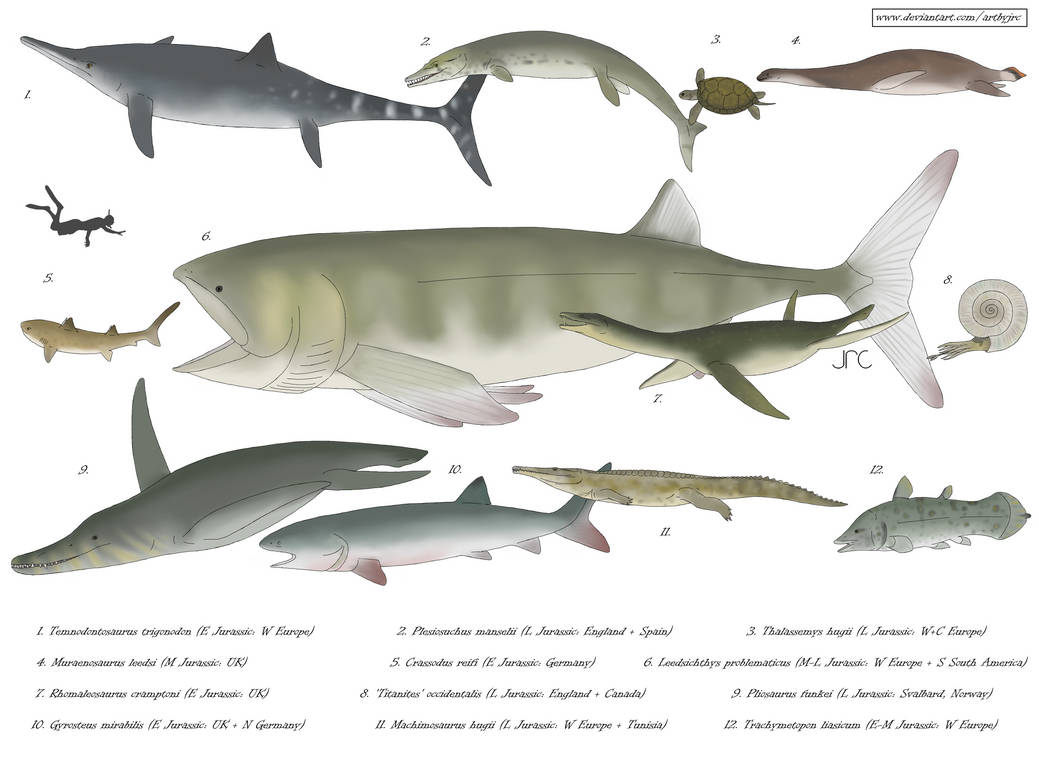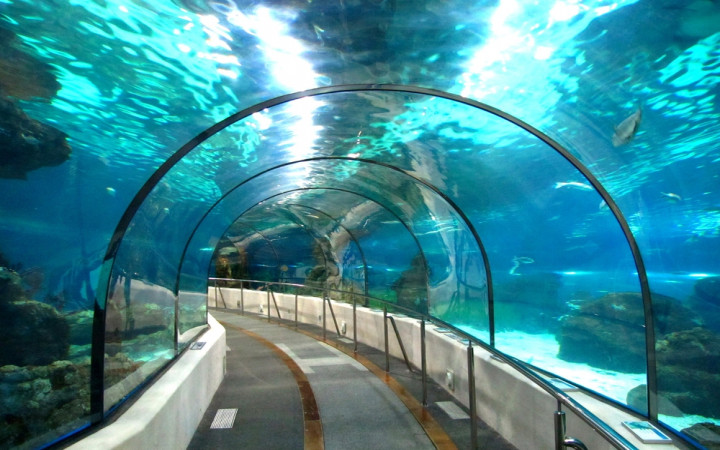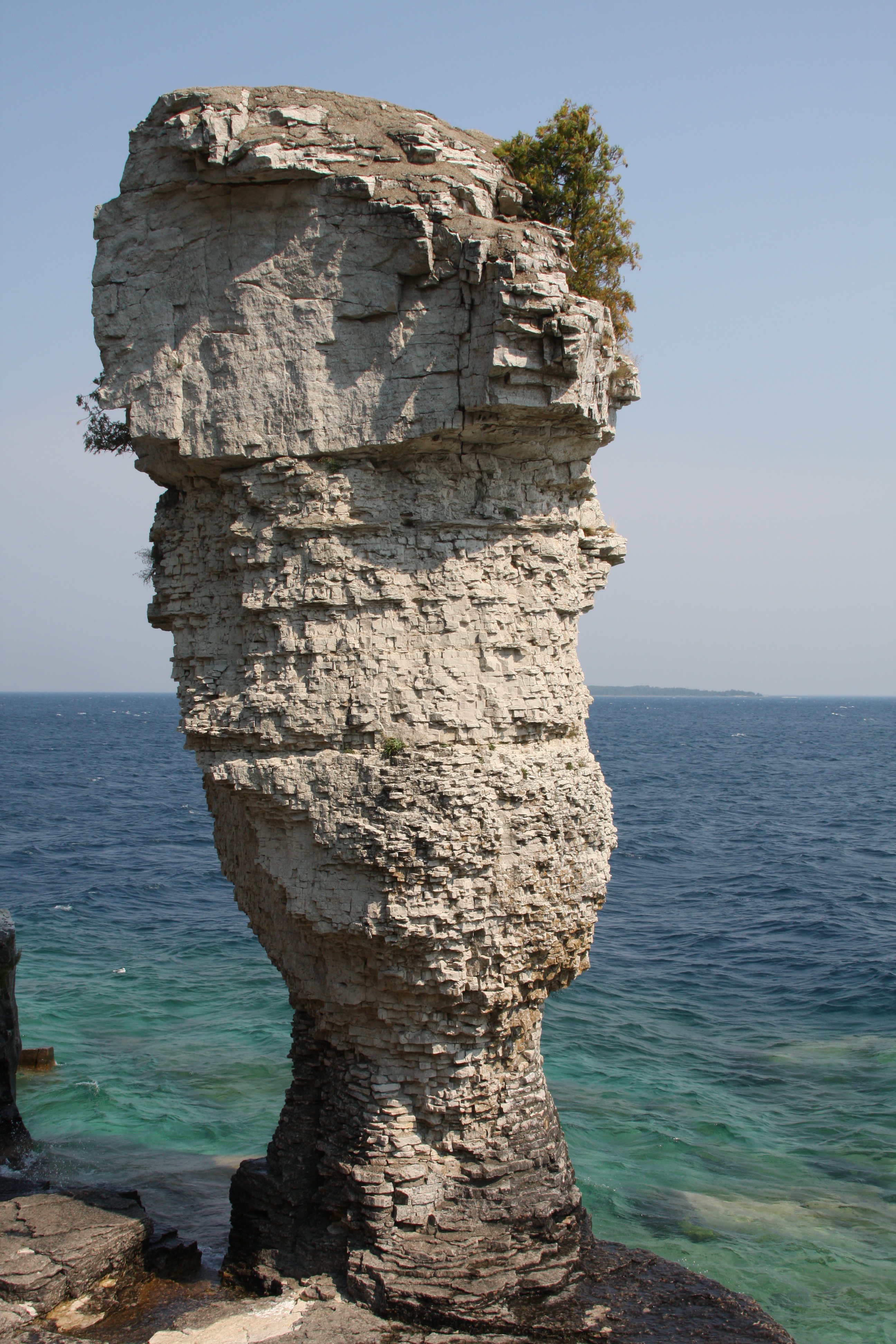Of the species that have been mentioned thus far, the species that I would recommend include Pliosaurus funkei, aka. Predator X, and Temnodontosaurus. I think it would be cool if we could get fresh water aquariums as well in order to get certain species, such as Pannoniasaurus, Kyhytysuka, and Mastodonsaurus. Some species that I think might work for this pack include:Which 5 Species and new Attractions would YOU choose for such an DLC ?
Excalibosaurus, A genus of ichthyosaur that lived during the Early Jurassic period in what is now England. It is characterized by the extreme elongation of the rostrum, with the lower jaw about three-fourths of the length of the upper jaw, giving the animal a swordfish-like look. The holotype specimen has a skull length of 78.5 cm (2 ft 6.9 in), while the largest specimen has a skull length of 1.54 m (5 ft 1 in). The larger specimen has a total length of 6.528 metres (21.42 ft). Its name means Excalibur's lizard.
Eurhinosaurus, A species of of ichthyosaur from the early Jurassic period found in England, Germany, the Benelux Union, France, and Switzerland. An adult individual could reach up to 7 meters (23 ft.) in length. Its name means well-nosed lizard. Its upper jaw was twice as long as its lower jaw.
Utatsusaurus: It is the earliest-known ichthyopterygian which lived in the Early Triassic period found in Utatsu-cho, which is part of Minamisanriku-cho, in Miyagi Prefecture, Japan and British Columbia, Canada.
Plotosaurus, An extinct genus of mosasaurs found in the Moreno Formation deposits along the San Joaquin Valley, California that lived during the Late Cretaceous. Unlike other mosasaurids, Plotosaurus possesses a morphology converging with those of ichthyosaurs, suggesting a much more advanced swimming adaptation than some of its close relatives. Plotosaurus possessed the highest level of aquatic adaptations in any mosasaur. It is thought to have been one of the fastest of the mosasaurs. Its name means swimmer lizard.
Moanasaurus, A genus of mosasaur from the Late Cretaceous period. Its fossil remains have been discovered in the North Island of New Zealand. Some remains from Antarctica are suspected of belonging to it. Its name is derived from the Māori word, moana, which means sea and Greek sauros that means lizard; hence its name means Sea Lizard.
Thalassotitan: Thalassotitan is an extinct genus of large mosasaurs that lived during the late Cretaceous period in what is now Morocco, around 66 million years ago. Thalassotitan was one of the largest mosasaurs. Its skull measured up to 1.3 meters (4.3 ft) in length, corresponding to a total length of 9–10 meters (30–33 ft). It got a lot of media attention after it was described. The genus name translates to Titan of the Seas. Its species name, atrox, is a Latin word that means "cruel" or "merciless", which references the species' trophic position as an apex predator and frequency of intraspecific bite marks on fossils.
Kourisodon, A species of mosasaur from late Cretaceous period Vancouver Island in British Columbia, Canada and the Izumi Group of Japan. It was a small mosasaur, with an estimated length of about 3.75 meters (around 12.3 feet). Kourisodon was originally described as a member of the Leiodontini, more recently as a Clidastine.
Globidens, An extinct genus of mosasaurid oceanic lizard classified as part of the Globidensini tribe in the Mosasaurinae subfamily. Specimens of Globidens have been discovered in Syria, North America, Morocco, Angola. Its name means globe teeth a reference to its highly rounded, globe-like teeth. It is thought to have had a durophagous diet. Specimens of Globidens have been discovered in Syria, North America, Morocco, and Angola.
Vallecillosaurus, An extinct genus of mosasauroid from the Late Cretaceous period, that lived in Mexico, in the state of Nuevo León. It was a relatively small reptile measuring less than 1 m (3.3 ft) long.
Eonatator, An extinct genus of marine lizard belonging to the mosasaur family that lived during the late Cretaceous period. Eonatator is known from the Smoky Hill Chalk Member of the Niobrara Chalk Formation of Kansas,from the Eutaw Formation and Mooreville Chalk Formation of Alabama (United States), from the Kristianstad Basin of southern Sweden, and the unit Nivel de Lutitas y Arenas of the Olini Group in La Mesa, Colombia. Eonatator was a small mosasaur, measuring approximately 2.6 meters (8.5 ft.) long. Its name means dawn swimmer.
Tethysaurus, An extinct genus of tethysaurine mosasauroid from the late Cretaceous period. It grew to be around 3 m (9.8 ft) long and weighed 70 kg (150 lb). The name means "Tethys' lizard of Nopcsa", a reference to the Greek goddess of the sea Tethys and also the name of the Tethys Ocean, an ancient sea between southern Europe and northern Africa.
Microposaurus, an extinct genus of trematosaurid temnospondyl. (Trematosaurids were a family of of large marine temnospondyl amphibians.) Fossils are known from the Cynognathus Assemblage Zone of the Beaufort Group (part of the Karoo Supergroup) in South Africa and the Rouse Hill Siltstone of Australia that date back to the Anisian stage of the Middle Triassic.
Aphaneramma, An extinct genus of marine temnospondyl amphibian. It lived during the early Triassic period approximately 240 million years ago. Fossils have been found in the Mianwali Formation of Pakistan, Madagascar, the Zhitkov Formation of Russia, and the Kongressfjellet Formation of Svalbard (Norway). It is believed to have primarily hunted fish. (Middle right of image)
Wantzosaurus, A genus of temnospondyl amphibian of the Trematosauridae family. Fossils have been found in the Early Triassic Middle Sakamena Formation (Sakamena Group) of what is now Madagascar. It showed adaptations for an almost completely aquatic lifestyle, having the ability to swim by lateral undulation. (Bottom left of the image)
Eardasaurus, a genus of thalassophonean pliosaurid from the middle Jurassic Oxford Clay Formation in England. The animal would have measured over 4.7 m (15 ft) long (the tail was not fully preserved) and possessed a high amount of teeth relative to other pliosaurs. The genus name is composed of the Old English word "eard", which means "home" or "dwelling", and "saurus", Greek for lizard.
Acostasaurus, An extinct genus of possibly Thalassophonean pliosaurid known from the early Cretaceous period of the Paja Formation, Colombia. Ithas an estimated size of over 4 metres (13 ft) in length and 1 metric ton (1.1 short tons) in body mass. It thought to have been adapted to see in dark and or murky waters.
Last edited:







